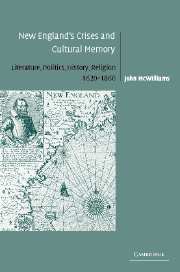Book contents
- Frontmatter
- Contents
- Acknowledgments
- Introduction: Crisis rhetoric: exclusion in New England history
- PART ONE PLANTATION AND SETTLEMENT
- PART TWO TIME OF TROUBLES
- Headnote
- 4 A cloud of blood: King Philip's War
- 5 The axe at the root of the tree: Scarlet Governors and Gray Champions
- 6 Race, war, and white magic: the neglected legacy of Salem
- PART THREE REVOLUTION
- Epilogue: “bodiless echoes”
- Notes
- Index
4 - A cloud of blood: King Philip's War
Published online by Cambridge University Press: 22 September 2009
- Frontmatter
- Contents
- Acknowledgments
- Introduction: Crisis rhetoric: exclusion in New England history
- PART ONE PLANTATION AND SETTLEMENT
- PART TWO TIME OF TROUBLES
- Headnote
- 4 A cloud of blood: King Philip's War
- 5 The axe at the root of the tree: Scarlet Governors and Gray Champions
- 6 Race, war, and white magic: the neglected legacy of Salem
- PART THREE REVOLUTION
- Epilogue: “bodiless echoes”
- Notes
- Index
Summary
The apocalyptic literary legacy of King Philip's War extends farther forward than currently recognized, to writers as different as Robert Lowell and Bharati Mukherjee. “The Park Street Cemetery,” the lead poem of Lowell's first book of poetry, immerses the reader in the “dusty leaves” and near forgotten spiritual/political pretensions of Boston's long-buried dead, culminating in the avenging depersonalizing question “What are Sam Adams or Cotton Mather?” When Lowell expanded this “graveyard” poem for inclusion in Lord Weary's Castle, he retitled it “At the Indian Killer's Grave,” thereby suggesting that the prevailing motivation of the Puritans had been, not salvation but domination, not king-killing but Indian-killing. The poem's narrator, clearly Lowell himself, discovers upon a visit to King's Chapel Burial Ground that the cracked gravestones of Boston's sanctified progenitors cannot hide a half-covered well in a ruined garden. Through the well, the narrator catches glimpses of the underworld fashioned by the Puritans' descendants, a mechanic hell where the screechings of the Green Line subway literally undermine the virtues that the blackened gravestones strove to commemorate.
The “Indian Killer” of the poem's title turns out to be an unnamed composite figure made up of Lowell's first American ancestors (John and Mary Winslow, whose cenotaph is in the cemetery), John's nephew Josiah Winslow (governor of Plymouth and commander of New England's army during King Philip's War) and Benjamin Church, the war hero who captured King Philip.
- Type
- Chapter
- Information
- New England's Crises and Cultural MemoryLiterature, Politics, History, Religion, 1620–1860, pp. 106 - 133Publisher: Cambridge University PressPrint publication year: 2004

